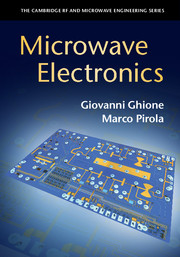Book contents
- Frontmatter
- Dedication
- Contents
- Preface
- Notation and Symbols
- 1 A System Introduction to Microwave Electronics
- 2 Passive Elements and Circuit Layout
- 3 CAD Techniques
- 4 Directional Couplers and Power Dividers
- 5 Active RF and Microwave Semiconductor Devices
- 6 Microwave Linear Amplifiers
- 7 Low-Noise Amplifier Design
- 8 Power Amplifiers
- 9 Microwave Measurements
- 10 CAD Projects
- Index
- References
7 - Low-Noise Amplifier Design
Published online by Cambridge University Press: 10 November 2017
- Frontmatter
- Dedication
- Contents
- Preface
- Notation and Symbols
- 1 A System Introduction to Microwave Electronics
- 2 Passive Elements and Circuit Layout
- 3 CAD Techniques
- 4 Directional Couplers and Power Dividers
- 5 Active RF and Microwave Semiconductor Devices
- 6 Microwave Linear Amplifiers
- 7 Low-Noise Amplifier Design
- 8 Power Amplifiers
- 9 Microwave Measurements
- 10 CAD Projects
- Index
- References
Summary
Introduction
Noise is a random unwanted signal, typically of small amplitude, superimposed on the ideal, deterministic voltages and currents of the circuit. In electronics, the term noise has two main interpretations.
Noise can be an interfering signal caused by a set of deterministic signals generated by an external circuit (or by another part of the circuit under consideration). Interference is caused by electromagnetic coupling of the interfering signal source with the circuit interconnects. While this kind of noise has an ultimately deterministic cause, it is often characterized in a statistical way. Electromagnetic compatibility analyzes and models this kind of noise, and develops circuit design approaches having low sensitivity to interferers.
On the other hand, noise (also called intrinsic noise) is a random signal generated by the very elements of the circuit (typically resistors, diodes, transistors; reactive elements are ideally noiseless). Such noise is intrinsically associated with the charge transport and generation-recombination processes in semiconductors and conductors, and cannot be eliminated, though its effect may be, as we shall see, alleviated through proper circuit design. Intrinsic noise is therefore an ultimate limit to the performance of the circuit in dealing with signals of very small amplitude. In fact, when the signal power is comparable with the noise power, the signal over noise ratio (S/N ratio) tends to unity, becoming incompatible with the detection of a signal in the receiver stage.
Due to the presence of intrinsic noise, the open circuit voltage (or short-circuit current) observed at the ports of any electronic device is affected by stochastic fluctuations having zero mean value, but nonzero mean square value (and therefore nonzero available electrical power). Since intrinsic noise is a random phenomenon, it should be characterized as a stochastic process, see Sec. 7.2 for a review.
This chapter is devoted to the basic principles of electrical noise in circuits, to noise device models (active and passive), and to the design of low-noise amplifiers, starting from the analysis of circuits including random noise generators (Sec. 7.3), and including a short discussion on the physical origin of electrical noise (Sec. 7.5). The minimization of the noise figure in a loaded two-port is addressed in Sec. 7.7, while the noise models of passive and active devices are discussed in Sec. 7.6 and Sec. 7.8, respectively.
- Type
- Chapter
- Information
- Microwave Electronics , pp. 352 - 410Publisher: Cambridge University PressPrint publication year: 2017



